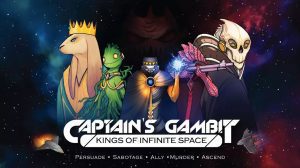Disclosure: Meeple Mountain received a free copy of this product in exchange for an honest, unbiased review. This review is not intended to be an endorsement.
One of the earliest non-traditional card games I played in my early days of tabletop gaming was Mille Borne. It was a card game where you tried to reach 1000 miles before anyone else while stopping your competition from moving by playing Hazard or Speed limits cards on them. It was a game released in the 50s, so the gameplay wasn’t very complex or strategic. As a time-waster, it was fun, but a little shallow. Shuffle Grand Prix is one of the first games from Bicycle Games, and when I read the rulebook, there was some clear inspiration from the classic Mille Borne game.
It wasn’t just nostalgia that reeled me in. The “Shuffle” portion of the title refers to everyone’s personal deck of cards. There are eight drivers in this game, each with their own deck. At the start of the game, you will pick two drivers and merge their decks together. Each driver has a unique passive ability, and you need to select one of them for your main driver, although they can be switched at a later time.
Based on that description, some of you will immediately think of the video game Mario Kart. You are right, this is the card version of Mario Kart. Each character has their own quirks and tools to mess with the other racers. You might pick Slingshot the Rocketeer because you love explosives or Emma the Engineer if you are a big fan of permanent upgrades. Another great feature about creating your own deck out of two preset decks is that it gives you a unique identity no one else has, so this small box offers a surprising amount of replay value.
Unlike Mille Borne, the goal here isn’t to reach a certain number of miles. Instead, there is a large distance deck, and the game ends if there are no distance cards left. Whoever has the highest distance wins. While this might sound like a game that will overstay its welcome, it doesn’t.
Since this is a family card game, turns are quite easy to understand. On your turn, the very first thing you do is draw a distance card. These distance cards are multiples of 25, with the highest distance card being 100. Once that is done you have the choice of playing an ability card, discarding one card and drawing one, or passing. After that, your turn is over.

Some Changes To The Norm
Unlike other typical “take that” card games, there are some cards in here that add enduring effects to this race. Sure, the typical “do a funny effect” cards or the play anytime cards are still stars of the show, but they aren’t the only actors on stage.
Some drivers, like Emma the Engineer, specialize in Equipment cards. These cards are permanent upgrades, and you only have two slots available. As you might hope, these cards provide positive effects, whereas the polar opposite Nerf card gives permanent negative effects to your opponents. My personal favorite is the Trap cards.
These cardboard nightmares stay on the field until a certain condition is met and will hurt the person who triggered it. The drawback is they can trigger for you as well.
In my very first game, four traps were played. They all revolved around drawing a particular distance card, and all of them would trigger if that happened. Everyone feared for their turn since it meant the real possibility of getting a spin-out, even for players with full health. It was like a kid-friendly version of Russian Roulette.
Fortunately, there isn’t any player elimination in this game. If you lose all four of your tire points, you simply spin out and start a new turn. A spin out involves removing all your cards from your hand, discarding your top distance card, and rewarding your opponent with a Trophy token. Trophy tokens are used to play additional ability cards on your turn, or to swap your drivers around.
One of the biggest complaints I have about “take that” games is the obvious decisions that befall you. The general philosophy behind these games is to be under the radar and attack the person in the lead. That’s still a concern here, yet the Nerfs, Equipment, and Trap cards tend to muddle the situation like an autumn coastal city.

Planning Your Pain
Let’s say your opponent, Mae the Scientist, decides to throw an “Entanglement” in your direction. This nerf card puts you and another player into a bind. Whenever one of you takes damage, the other takes the same amount of damage as well. For the sake of this example, let’s pretend you know they have the “According to these Models” card, and it’s going to deal 5 damage to you. Everyone’s maximum health is 4.
Your primal instincts will immediately suggest you go after Mae the Scientist for putting you in this situation. Yet you also can’t ignore the Entanglement card since other players can take advantage of that, including the person who you are bound to.
This is one of the reasons why I prefer this game over the big dogs like Munchkin, Exploding Kittens, or Dungeon Mayhem. Besides not overstaying its welcome, the extra mechanisms force you into awkward scenarios with no straightforward answer. The limit of playing only one card per turn also puts pressure on your choices since you have to calculate the opportunity costs of playing cards in a game where aggressive play is highly rewarded. You might not be able to play those other cards the following turn, and low health is as good as blood in the water for the sharks.
Even though I am giving this game some applause, I also need to point out that this is still a “take that” game, and it does come with the familiar baggage. The luck of the draw and dogpiling on the leader is still the focal point here. Don’t expect a deeply strategic game where the most clever will win. This is not an evolution of the genre; it’s simply a refinement of it, and it embraces the chaos that comes with that. This won’t turn everyone into a fan.
Another gripe I want to bring up has to do with the production. The artwork is far too simplistic for my liking, and the color palette used here looks like the aftermath of the Easter Bunny attending a kegger. For a game focused on its characters, the design and artwork just don’t work. Going back to Mae the Scientist, her entire concept is “woman riding a shuttle” because she is a scientist. It’s so generic that it’s forgettable. Out of the cast of eight characters, the only ones that stuck out to me were Remus the Wizard and Kaetana the Musician. Remus is a crazy wizard riding on a carpet with flying creatures swarming him, one of them that he uses as a hat. Kaetana rides a motorcycle with a color scheme that works quite well despite being an unorthodox color pairing. They stand out due to their odd design, where the rest of the cast falls into familiar tropes.

Annoying Distance Cards
Outside of my artwork complaints is the use of the Distance cards themselves. The rulebook suggests laying them out in a straight line, and this sounds okay until you realize that playing two or three players will lead to a mile-long line of cards. Two easy solutions to this would’ve been reducing the number of Distance cards in the deck depending on the number of players, or adding dots under the numbers representing the multiples of 25 (e.g. 50 has two dots, 100 has four dots).
As a quick family game, I was impressed with the presentation. The idea of combining cards to craft your own deck and abusing the different tools is something not often seen in other “Take that” games. That being said, it is still a very lightweight game with the familiar issues of the genre that will only appeal to the crowd already accustomed to this environment. It isn’t my favorite filler game, and I don’t see myself playing this often. However, if you are a fan of these types of games, this is better than most of its competition.
Review copy provided by the publisher. You can purchase a copy on Amazon US











Add Comment